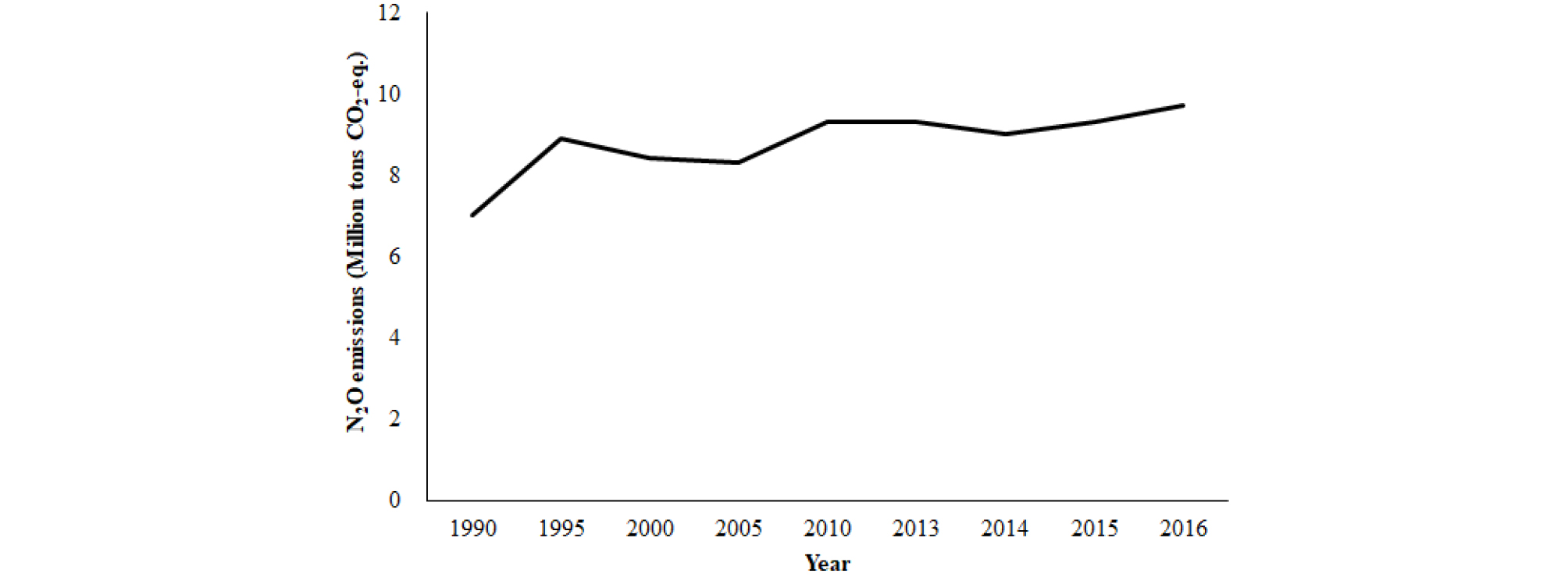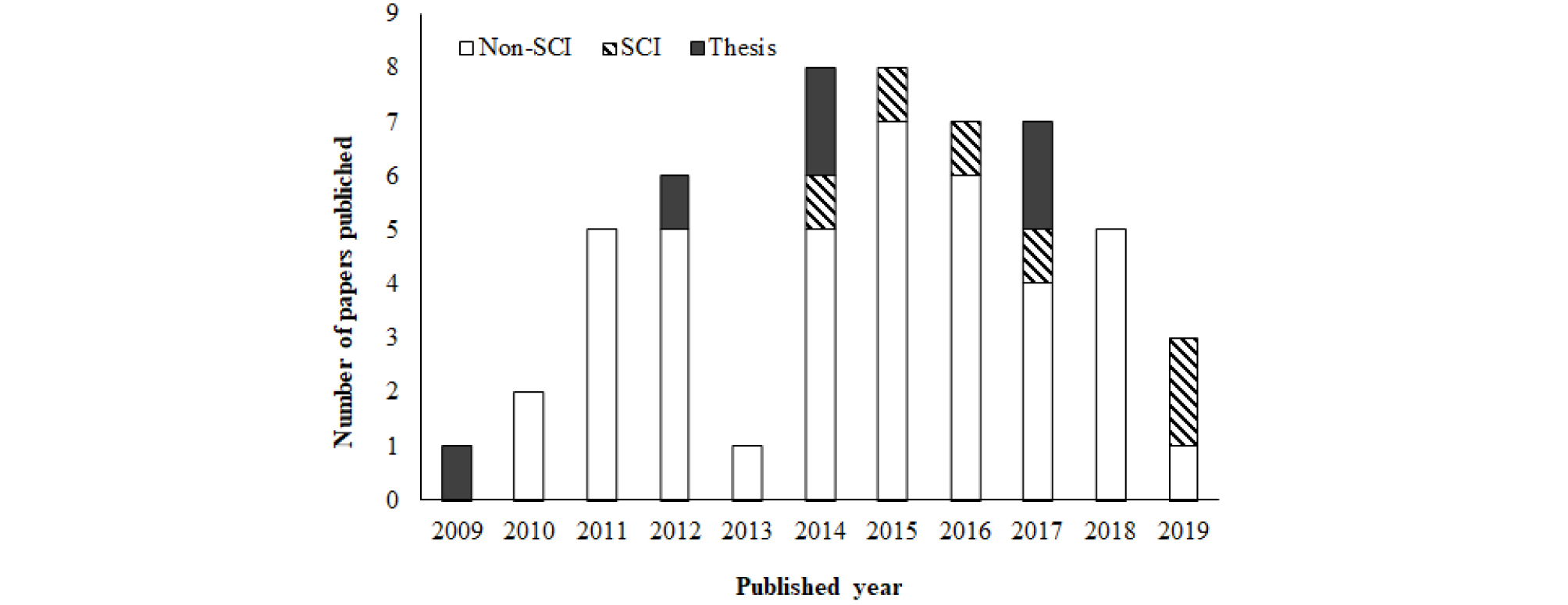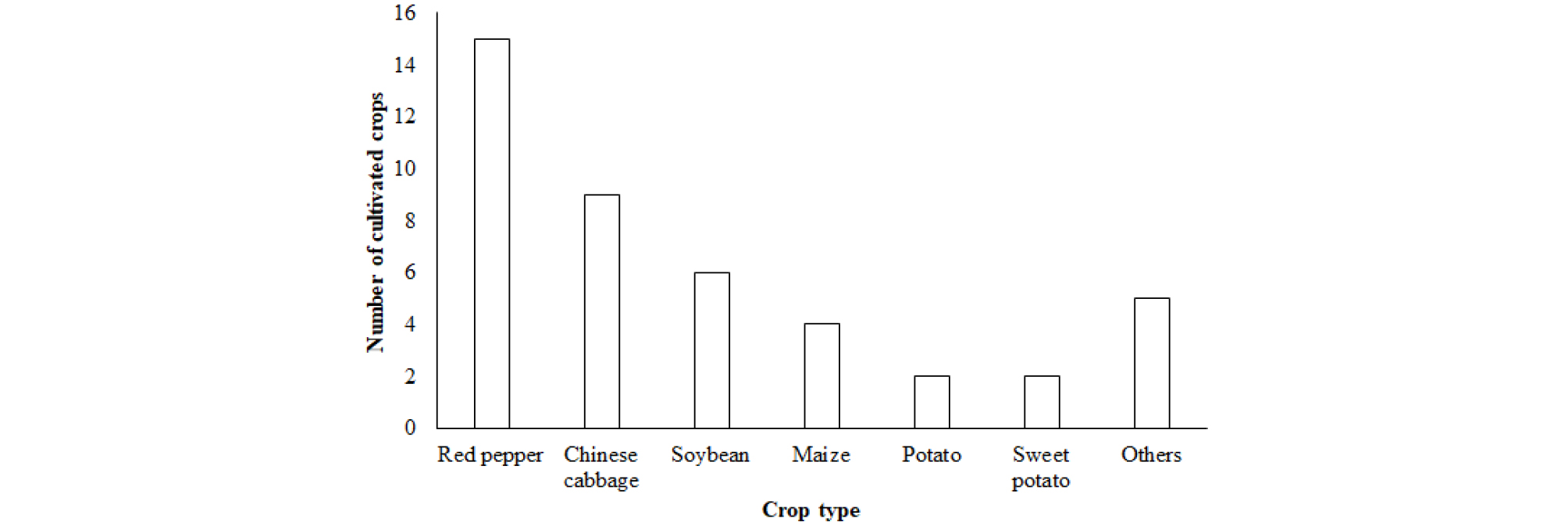Introduction
대기 중 온실가스 농도는 산업혁명 이후 급격히 증가하였고, 증가된 온실가스에 의해 지구의 평균 대기온도는 지속적으로 상승하였다. 대기온도 상승은 지구환경 변화를 가속화 시켰고 이에 따라 기상이변의 피해 발생 빈도가 증가하였다 (IPCC, 2014). 특히 농업은 환경과 생태계에 의존하기 때문에 기후변화에 크게 영향을 받는다. 기후변화로 식량 생산에 약간의 차질이라도 생기면 인류의 생존까지 위협을 받을 수 있다. 따라서 세계 각국은 지구온난화에 따른 기상이변의 피해를 최소화하기 위한 온실가스에 대한 배출량 평가 및 저감기술 개발과 감축정책을 추진하고 있다. 유엔 기후변화협약 제 3차 당사국 총회에서 교토의정서 (Kyoto Protocol, 1998)를 체결하여 기후변화의 주범인 주요 온실가스를 정의하고 선진국 중심으로 온실가스 감축 의무를 부여하였다. 그 후 제 21차 유엔 기후변화협약 당사국 총회에서 파리협정 (Paris Agreement, 2015)을 이끌어 모든 당사국에게 온실가스 감축의무를 부여한 신기후체제가 출범하였다. 이에 따라 우리나라는 2030년의 온실가스 배출량 전망치 (BAU, Business as usual) 대비 37%를 감축하는 것을 발표하였다. 농업 재배와 축산분야를 포함한 비에너지 부문은 BAU 대비 7.9%에 해당하는 약 1.6 백만톤 CO2eq. (Carbon dioxide equivalent) 의 감축 목표가 설정 되었다.
국가 온실가스 정보센터에서 2018년에 발간한 국가 온실가스 인벤토리 보고서 (GIR, 2018)에 의하면 2016년 국내 농업 재배분야 온실가스 배출량은 11.8 백만 톤 CO2eq.으로, 2015년 대비 0.84% 감소하였고, 1990년 대비 23.4% 감소하였다. 농업 재배분야 온실가스 배출량 중 큰 비중을 차지하는 것은 벼 재배 시 논에서 발생하는 메탄 (CH4, methane)과 농경지토양에서 비료시용 등에 의해 발생하는 아산화질소 (N2O, nitrous oxide)이다. 2016년 기준 CH4과 N2O은 각각 6.1, 5.7 백만 톤 CO2eq.이 배출되었다 (Table 1). 벼 재배 시 배출되는 CH4는 1990년 이후 벼를 재배하는 논 면적 감소로 지속적으로 낮아지는 추세이지만, N2O 배출량은 1995년 이후 증감을 반복하며 전체적으로 증가하는 경향을 보이고 있다 (Fig. 1). 따라서 농경지에서 발생하는 N2O에 대한 배출평가 연구가 요구 되었다. 2008년 저탄소 녹색성장 국가비전 선포 이후 국내 농경지에서 N2O 배출관련 연구가 지속적으로 증가하여 왔다. 하지만 연구결과에 대한 체계적인 분석과 논의는 미미한 실정이다.
Table 1. Greenhouse gas emission in agricultural cultivation sector in Korea from 1990 to 2016.(Unit : Million tons CO2 eq.)
GIR, 2018따라서 본 연구는 2009년부터 2019년 9월까지 우리나라 농경지에서 N2O 배출특성 평가 및 감축기술 개발과 관련된 연구 결과를 중심으로 연구의 시기와 목적에 따른 지금까지의 연구동향을 분석하였다. 그리고 N2O 감축기술의 영향평가를 통해 국내에서 수행된 감축기술별 특성에 대해 논의하고 향후 국가별 온실가스 감축방안 구축을 위한 연구의 기초자료 제공 및 후속 연구의 방향성을 제시하고자 한다.
국내 농경지 N2O 연구 현황
국내 농경지 N2O 배출관련 연구 동향을 분석하기 위하여 주요 국내외 학술지에 게재된 논문과 국내 대학에서 작성한 학위논문을 중심으로 2009년부터 2019년도 9월까지 총 53편의 연구 논문을 수집하여 분석하였다. 연구의 시기별 동향은 2008년 저탄소 녹색성장 국가비전 선포 이후인 2009년부터 관련 연구에 대한 논문이 게재되기 시작하였다. 이후 농경지 N2O 관련 논문은 2012년 까지 증가하는 경향을 보였고 2014년에서 2018년까지 매년 5편 이상 국내외 학술지에 게재되었다 (Fig. 2).
국내 농경지 N2O 연구 목적별 분류
연구 목적에 따라 농경지에서 토성, 작물재배시기, 재배작물종류, 비료 종류 및 투입량, 멀칭방법, 경운방법 등을 통해 N2O 배출량을 조사한 연구를 ‘N2O 배출 특성’으로 분류 하였으며, N2O 배출 감소와 관련된 요소들을 이용하여 N2O 배출량 감소기술 개발을 목적으로 하는 연구를 ‘N2O 배출저감기술 개발’로 분류하였다. N2O 배출량 조사 후 국가 고유계수로 등록하기 위한 배출계수를 산정한 연구를 ‘N2O 배출계수 개발’로 분류하였으며, 이전의 연구결과를 토대로 배출계수를 산정하고 이에 활동자료를 적용하여 국내 농경지 N2O배출량 평가한 연구를 ‘N2O 인벤토리 평가 연구’로 분류하여 분석하였다 (Table 2).
Table 2. Classification according to nitrous oxide emission research trend.
N2O 배출 저감기술 개발은 15편 (28.3%)으로 가장 많았고, 그다음으로 N2O 배출 특성이 13편 (24.5%)으로 조사되었다. N2O 배출계수 개발은 12편 (22.6%)이었고 N2O 인벤토리 평가연구는 11편 (20.8%)으로 조사되었다. 온실가스 관련 연구에서 N2O 배출 저감기술 개발이 가장 많이 이루어진 것은 2030년 우리나라의 온실가스 감축 목표를 배출량 전망치 대비 37%로 확정 감축하겠다는 우리나라 정부의 발표와 국제사회에서의 신 기후체제의 기반이 되는 파리협정 등에 의한 것이며, 앞으로도 국내외 온실가스 관련 연구가 요구됨으로써 지속적으로 증가 할 것으로 판단된다.
국내 농경지 N2O 연구 시험조건별 분류
농경지에서 배출되는 N2O를 직접 측정한 연구논문의 경우 연구 방법, 연구기간, 공시토양의 특성, 재배작물에 따라 농경지 N2O 배출연구 현황을 분석하였다. 연구방법은 우선 실내외 시험을 구별하였고 실내 시험은 바틀, 컬럼, 포트 시험별로 구별하였으며 각각 시험방법별 시험 수행기간을 평가하였다. 농경지에서 배출되는 N2O는 농경지 토양의 특성의 영향을 많이 받기 때문에 각각 시험에 사용한 공시토양의 토성, pH, 유기물 함량을 각각 분류하였고, 시험토양에 재배한 작물에 따라 현재까지 수행된 연구현황에 대해 분석하였다.
농경지에서 N2O 배출에 대한 연구 중 연구방법별 수행기간을 분류한 결과는 Table 3과 같다. 연구방법은 우선 실내외 시험을 구별하고 실내 시험은 바틀, 컬럼, 포트 시험으로 구별하여 각각 시험방법별 시험 수행기간을 분류하였다. 실내 시험의 대부분 연구기간은 1년 이하인 반면 실외 필드에서 수행된 연구는 56.1%가 1년 이상을 거쳐 시험을 수행하였다 (Table 3). 실내 연구는 농경지 토양에서 N2O 배출 및 감축량과 원인 기작을 분석하기 위해 격리된 조건에서 시험이 수행되었고, 실외 연구는 작물을 재배하면서 작물의 영향을 포함한 N2O 배출량을 요인에 따라 비교 평가하는 시험이 수행되었다.
Table 3. Number of experiment types and duration.
| Experiment type | 1 - 3 months | 3 - 6 months | 6 - 12 months | > 1 year |
| Bottle | 1† | 1 | - | - |
| Column | - | 1 | - | - |
| Pot | 1 | 1 | - | 1 |
| Field | 3 | 9 | 6 | 23 |
| Total | 5 | 12 | 6 | 24 |
농경지에서 N2O 배출에 대한 연구 중 공시토양의 특성을 분류한 결과는 Table 4와 같다. 농경지 토양의 토성, pH, 유기물 함량은 농경지에서 배출되는 N2O에 큰 영향을 주는 요소로 평가되고 있다 (Lal et al., 2011). 공시토양의 토성은 사양토 10편, 양토 8편, 식질양토 7편순으로 연구되었고, pH 대부분 약산성인 5.4 - 7.0 범위에서 72.6% 연구가 수행되었다. 유기물 함량은 10 - 20 g kg-1 범위에서 44.8% (26편)가 수행되었고 21 - 30 g kg-1 범위에서 25.9% (15편)가 수행되었다. 공시토양은 다양하면서도 광범위하게 시행되었다.
Table 4. Number of experimental soils texture, pH and OM in this article.
| Soil texture | pH | OM | |||||||||
| Sandy loam | Loam | Silty clay loam | others | (1:5) | g kg-1 | ||||||
| < 5.4 | 5.4 - 6.0 | 6.1 - 7.0 | < 7.0 | < 10 | 10 - 20 | 21 - 30 | < 30 | ||||
| 10† | 8 | 7 | 19 | 4 | 18 | 27 | 13 | 7 | 26 | 15 | 10 |
농경지에서 N2O 배출에 대한 연구 중 재배작물별 분류한 결과는 Fig. 3과 같다. 재배작물은 고추 재배지에서 15편 (34.9%)으로 가장 많았고, 배추 재배지에서 9편 (20.9%), 콩 재배지에서 6편 (14.0%), 옥수수 재배지에서 4편 (9.3%), 토마토 재배지에서 2편 (4.7%), 고구마 재배지에서 2편 (4.7.%) 순으로 나타났다. 그 외 호밀, 브로콜리, 당근, 마늘, 헤어리배치 재배지에서 각각 1편의 연구가 수행되었다. 주로 우리나라에서 재배하는 밭작물 위주로 연구가 수행되었고 토마토 등 일부 시설재배지 작물에 대한 연구도 진행되었다.
국내 농경지 N2O 배출 감축 연구
N2O의 지구온난화잠재력 (GWP, Global warming potential)이 298이며, 지구온난화 기여율은 5% 이상인 것으로 알려져 있다 (IPCC, 2007). 농업분야 농경지 토양에서 발생하는 N2O를 저감하는 기술이 필요한 실정이다. 따라서 국내에서도 2009년 이후 N2O 배출 저감기술 개발은 15편 이상 연구가 진행되었다. 그리고 농경지에서 N2O가 배출되는 특성으로 Iserman (1994)은 농경지 토양에서 N2O는 81%가 질소비료 투입에 의해 배출된다고 하였다. 질소비료로 암모늄태 질소원을 토양에 투입하면 가수분해되어 NH4+ 형태로 변하고 자급영양생물인 질화균에 의해 질산화과정을 거쳐 질소산화물 형태로 달라지며 탈질균 호흡내의 전자 수용체의 탈질 과정을 통해 N2가 배출 된다. 그 중 질산화과정과 탈질과정 중 중간 생성물인 N2O가 생성되는 특성을 갖는다 (Firestone and Davidson, 1989; Davidson et al., 1993). 이러한 특성을 고려하여 농경지에서 N2O 배출을 감축하고자 바이오차 투입, 녹비작물 투입 등 다양한 연구가 수행되었다 (Table 5).
Table 5. Main mitigation measures for nitrous oxide emission.
| Mitigation measures | Mitigation effects | Data source |
| Adding biochar | 24.6% | Seo et al., 2012 |
| -23.8% to 41.4% | Park et al., 2014b | |
| 16.4% to 20.6% | Kim et al., 2014c | |
| -24.6% to 48.3% | Park et al., 2015 | |
| 12.3% to 39.3% | Park et al., 2016b | |
| -74.0% to -9.0% | Lee et al., 2017b | |
| 31.9% to 48.1% | Lee et al., 2017a | |
| 81.8% to 86.9% | Lee et al., 2018b | |
| Adding green manure | 19.2% to 71.3% | Kim et al., 2011b |
| 38.6% | Seo et al., 2012 | |
| 4.7% to 17.6% | Yoo et al., 2015 | |
| -17.0% to -3.8% | Yoo et al., 2016 | |
| 44.9% to 56.2% | Kim et al., 2018a | |
| No tillage | 7.3% to 62.4% | Kim et al., 2011b |
| 15.2% to 28.6% | Yoo et al., 2015 | |
| 5.7% to 35.7% | Yoo et al., 2016 | |
| Adding inhibitor | 18.4% to 78.5% | Ju et al., 2018 |
| Adding slow release fertilizer | 56.2% to 64.3% | Kim et al., 2018a |
| Water management | 13.2% to 40.2% | Kim et al., 2014a |
농경지에서 N2O 배출을 저감하기 위해 바이오차를 농경지에 투입하여 N2O배출량을 비교평가한 연구는 2012년부터 현재까지 총 8편 연구논문이 게재되었다. Lee et al. (2018b)은 농가에서 버려지는 다양한 바이오매스 부산물을 바이오차로 변환한 후 토양에 적용하면 배출되는 N2O를 80% 이상 감축할 수 있다고 하였고, Lee (2017b) 연구를 제외하면 대부분의 연구에서 배출되는 N2O의 20% 이상 감축할 수 있다고 하였다. 반면 Lee (2017b)은 농경지 토양에 투입된 바이오차가 질산화반응을 촉진하여 N2O를 9.0 - 74.0% 증가하였다는 연구결과를 도출했다. 이러한 N2O 배출량의 차이는 토양의 수분함량의 영향에 의한 것이다. 토양 수분함량은 토양 내 질소순환 과정에 영향을 주며, 토양이 습윤 상태일 때에는 질소순환 과정 중 미생물에 의한 탈질현상이 촉진되어 토양으로부터 N2O 배출이 증가한지만 (Reay et al., 2012), 건조 상태일 경우 질산화과정이 우세하여 중간생성물로 N2O가 배출되기 때문이다. 즉 바이오차는 토양 내 우세한 질소순환 과정에 따라 N2O배출량에 영향을 받음을 확인할 수 있다.
화학비료 대체 녹비를 농경지에 투입하여 N2O배출량을 비교 평가한 연구는 2011년부터 현재까지 총 5편 연구논문이 게재되었다. Kim et al. (2011b)의 연구결과에 의하며 N2O를 최대 71.3% 감축할 수 있지만, Yoo et al. (2016)의 연구결과에서는 N2O가 17.0% 증가함을 나타냈다. 농경지 토양에서 N2O는 81%가 질소비료 투입에 의해 배출되기 때문에 (Iserman, 1994) 녹비를 투입함으로 화학비료 시용량을 줄일 수 있어 대체 량만큼 N2O배출을 저감할 수 있지만, N2O 배출은 토양의 유기태탄소 함량이 높을 때 증가하는데 (Skiba et al., 1998) 이는 녹비 투입에 의해 증가된 유기태 탄소함량에 의해 일부 N2O배출이 증가한 것으로 사료된다.
무경운을 통해 농경지에서 배출되는 N2O량을 비교 평가한 연구는 2011년부터 현재까지 총 3편 연구논문이 게재되었다. 3편 연구논문을 분석한 결과 5.7 - 62.4% 까지 농경지에서 배출되는 N2O를 감축시킬 수 있었으며, 무경운을 통해 토양 교란을 방지하여 질소순환과정의 가속화를 줄일 수 있어 토양으로부터 배출되는 N2O를 저감할 수 있을 것으로 사료된다.
농경지에서 N2O 배출을 저감하기 위해 요소분해억제제 (Ju et al., 2018), 완효성비료 시용 (Kim et al., 2018a), 물관리 (Kim et al., 2014a) 통한 연구는 각각 1편씩 연구논문이 게재되었다. 고추와 배추 재배지에서 요소분해효소 억제제 NBPT (N-(n-butyl) thiophosphoric triamide)함유 비료를 시용하여 작물 생육량은 유지하면서 N2O배출을 저감 시킬 수 있었다. 고추 재배지에서 LCU (Latex coated urea)효과 지연성 완효성비료 투입을 통해 작물 수확량과 비료이용효율을 증진시켰으며 N2O배출을 저감 시킬 수 있었다. 고추 재배지에서 토양 수분장력을 -50 kPa 으로 점적관수 하였을 때 식양토 및 사양토 모두 작물 수확량이 증가하였고 N2O배출은 저감되었다.
농경지 토양에서 고추재배 시 사양토와 식양토에서 토양수분과 토양온도에 따른 N2O 배출에 대한 상대적 기여도를 평가한 결과 사양토에서는 토양수분이 66.0%, 토양온도가 21.7%로 평가되었고 식양토에서는 토양수분이 47.7%, 토양온도가 6.2%으로 평가되었다 Kim et al. (2014a). 일반적으로 토양 수분함량은 토양 내 질소순환 과정에 영향을 주며, 토양이 습윤 상태일 때에는 질소순환 과정 중 미생물에 의한 탈질현상이 촉진되어 토양으로부터 N2O 배출이 증가하지만 (Reay et al., 2012), 토양 수분함량이 40%이상 초과할 경우 질소의 탈질과 N2O 생산 및 확산을 억제된다 (Jian-gang et al., 2007). 토양온도의 증가는 탈질에 관여하는 미생물을 증가시켜 N2O 배출량을 촉진하지만 30°C 이상의 고온에서는 N2O 배출이 억제된다 (Renault and Sierra, 1994). 즉 대기온도와 강수량의 변화는 토양 온도와 토양 수분함량에 영향을 주며 이에 따른 농경지 토양에서 배출되는 온실가스도 간접적인 영향을 받기 때문에 추후 장기적인 기상, 기후의 환경영향에 따른 온실가스 배출특성을 파악하는 연구도 필요할 것이다.
Conclusion
본 연구는 2009년부터 2019년까지 국내에 게재된 논문 중 밭에서 N2O 배출과 관련된 연구 결과를 조사하여 분석하였다. 정부가 2009년 온실가스 배출량의 감축 목표를 처음 발표하면서 연구가 활발해졌으며, 연구 목적별로 분석한 결과, 주로 N2O 배출 저감기술 개발 분야가 많이 이루어져 왔으며, N2O 배출 특성, N2O 배출계수 개발, N2O 배출량 인벤토리 평가 연구가 이루어져 왔다. 농경지에서 배출되는 N2O를 감축하기 위해 토양에 바이오차 및 녹비를 투입하거나 무경운 기술을 적용한 연구들이 평가되었다. 이러한 N2O 감축기술에 대한 연구는 2030년 우리나라의 온실가스 감축 목표를 배출량 전망치 대비 37%로 확정 감축하겠다는 정부의 발표와 국제사회에서의 신 기후체제의 기반이 되는 파리협정 등 국내외 온실가스 관련 연구가 요구됨으로써 지속적으로 증가 할 것으로 판단된다. 따라서 추가적인 온실가스 감축기술 개발이 필요하며 개발된 기술들의 온실가스 저감효과를 평가하는 연구와 더불어 농가에 활용 될수 있도록 온실가스 감축사업과 연계할 수 있는 검인증 방법을 포함한 방법론 구축 등이 필요하다. 이후 농업분야 온실가스 감축사업인 배출권거래제 외부사업, 농업농촌 자발적 온실가스 감축사업, 저탄소농축산물 인증제 등과 연계하여 농업현장에서 활용할 수 있도록 해야 한다.







